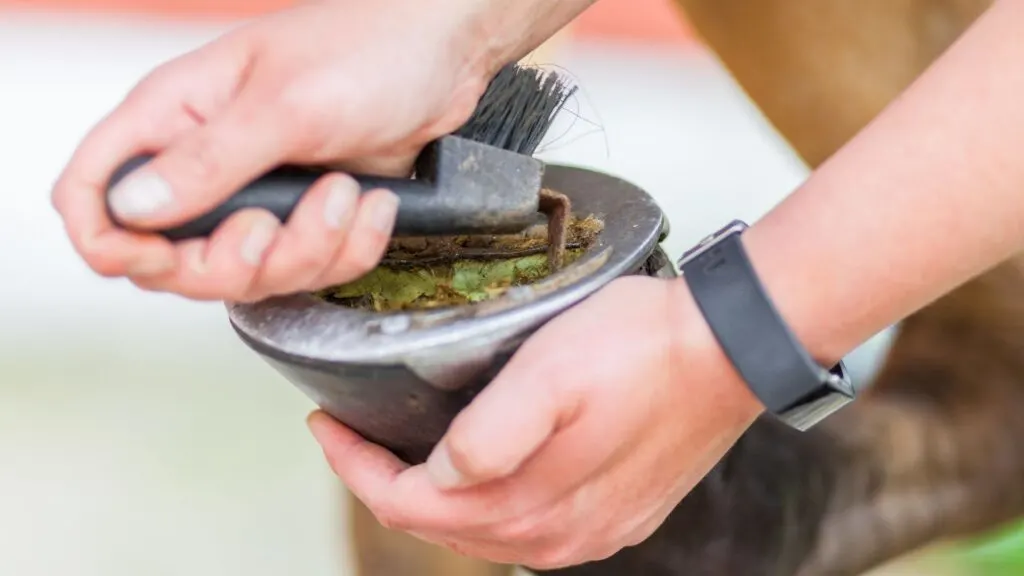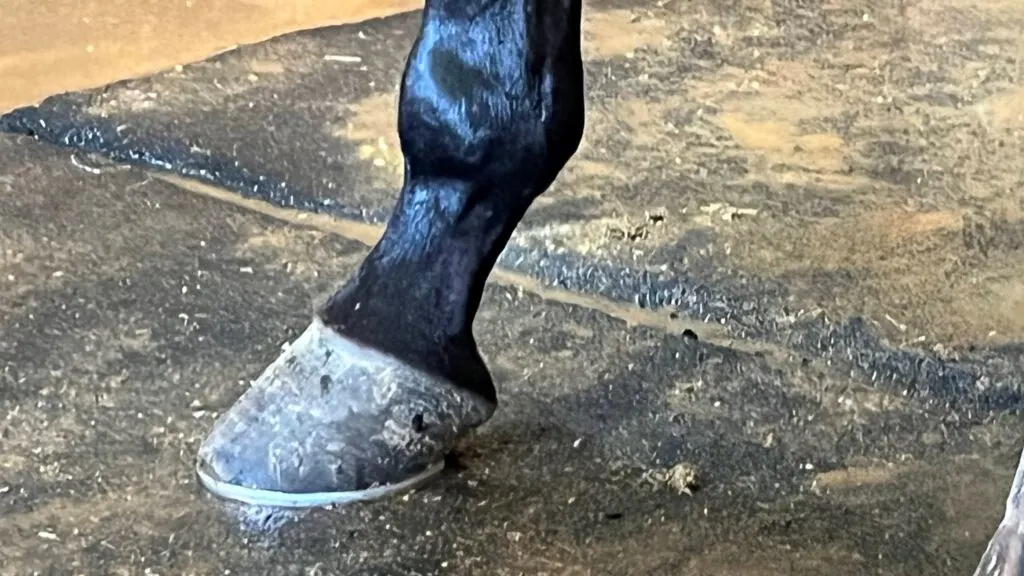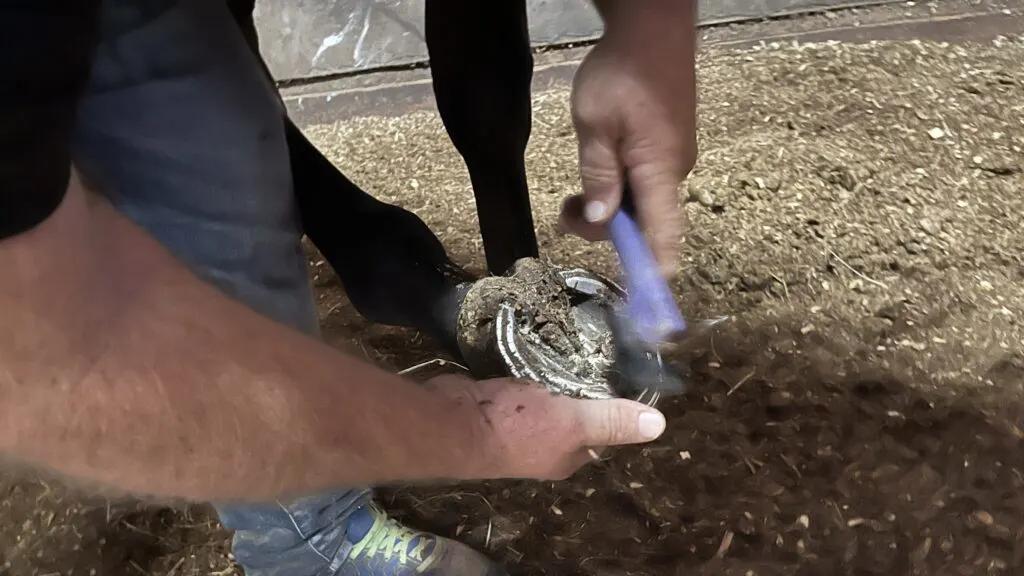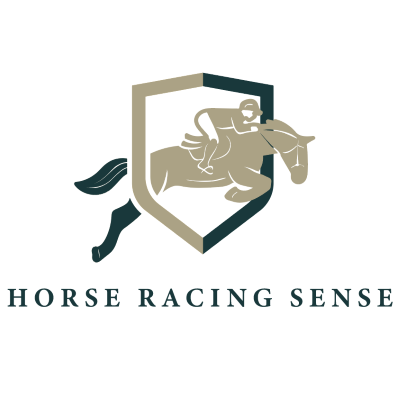Last updated: April 3, 2023
Any links on this page that lead to products on Amazon are affiliate links and I earn a commission if you make a purchase. Thanks in advance – I really appreciate it!
While I picked the hooves of the third horse, My grandson asked me about hoof care and why it’s so important for their horses. I explained the basics and thought there were some helpful things I could share here.
In general, you should use a pick and clean out your horse’s hooves daily. It’s an important task that can prevent infections and injuries such as thrush and stone bruising. Most horses need their hoofs trimmed every six to eight weeks; however, show horses may need trimming more often.
Hoof care is one of the most important aspects of owning a horse. Your horse’s feet support its weight and absorb impact; you must take good care of them if you want to keep your horse healthy.
This blog post covers some hoof care tips, including horse trimming tools, plus how often hoofs need to be cleaned and trimmed.

Why cleaning your horses’ hoofs is important.
Raising a healthy horse can be difficult because you must stay ahead of the issues before they become big problems. Some people pay too much attention to their horses’ coats and not enough to hoof care, which often leads to serious complications.
The fitness of a horse’s feet is pivotal to its overall health and performance. Some factors that contribute to healthy feet include proper diet, exercise, genetics, and maintenance. By maintenance, I mean picking your horse’s hoofs and trimming them when needed.
The simplest way to care for your horse’s hooves is to keep them clean, which isn’t much work if you know the basics. It should be a daily routine, and you must do it before and after each ride.
Pick out its feet, pry any debris stuck in there, clear the crevice of the frog, and clean the surface with a stiff brush. As you complete the process, look for signs of issues such as cracks, abscesses, punctures, and thrush.
Lifting your horse’s feet each day gets your horse comfortable with you handling his legs and feet; this is important. I was with a rider whose horse started limping on a trail ride. When the rider tried to lift its foot to see what was wrong, his horse shied away and refused to let him near.
You could tell the horse wasn’t used to the rider lifting his leg. Plus, checking your horse’s feet daily lets you check for injuries and heat in their lower legs. Do not overlook the slightest problem because early treatment can prevent it from getting worse. If you notice an unfamiliar problem, contact your vet or farrier.

Understand what is normal
Hoof care is more than just looking for visible signs of problems or injuries while cleaning the hooves, you must also know the subtle signs of something being amiss. Everything boils down to understanding what is normal.
If you handle your horse’s feet daily, you know when they feel hotter than normal. Most horse hooves are slightly warm. If they are hot, it could be an indicator of infection.
They should feel very slightly warm when everything is fine. Next, pay attention to the digital pulse and check if it is elevated, which could signify laminitis in horses. Check the frog and assess its texture and firmness, which should be much like a new rubber eraser; if you notice something out of the ordinary, contact your vet.
Choose between shod and barefoot.
As an owner, proper hoof care means you have to decide whether it’s better for your horse to be shod or go barefoot. When we give our horses a break from training, we take their shoes off; this allows their hoofs and soles to toughen.
But the decision to remove their shoes depends on several factors, such as the current hoof health, the animal’s living environment, and personal preferences.
If the hooves are healthy, you can forgo shoes and keep them unshod. Often horses transition from shoes to barefoot with the help of hoof boots are worn to help. Conversely, some horses benefit from being shod if they are involved in sports or have a weak hoof structure.
Letting the animal go barefoot isn’t a good idea if it lives in a moist environment because it weakens the hoof walls.

Hoof health
Horse owners need to align their hoof care routine according to the changes in the season. Depending on the climatic conditions of your area, seasonal changes can lead to moisture issues with the animal’s hooves. You have to ensure they do not get dry and crack or soft in wet weather.
Fortunately, it is easy to deal with both situations, provided that you get into the action early. Applying a moisturizer to the sole can prevent cracking during dry weather. You can use a hoof sealant to block out excessive moisture in wet weather.
Be extra conscious in the summer.
If you consistently use hoof conditioners and sealants, horses’ hooves will typically do well year-round. But sometimes, things can get harder to manage in the summer when the weather fluctuates between wet and dry.
While you may use evening turnout as a strategy to avoid biting insects, it can lead to swelling and softening of hooves due to prolonged contact with dew-soaked grass. They also tend to dry and contract during the day.
The repetition of this cycle can cause the horseshoe nails to loosen. It means that you need to go the extra mile with your hoof care routine at this time of the year. Start taking the proper measures in late spring, continue through the summer, and follow them till early fall.
Hoof health and nutrition
Nothing is more important than good nutrition to maintain your horse’s hoof health. A balanced diet can alleviate many equine health issues, so ensure that you feed it quality hay that delivers the correct levels of minerals and vitamins.
Access to clean drinking water is equally crucial. You can consider using supplements to fill the nutritional gaps. Essential supplements for healthy hooves include zinc, biotin, iodine, and methionine. Speak to a veterinarian or horse nutritionist to recommend a good nutrition plan for the animal and follow it religiously.
Keep it active
Horse owners must do their bit for hoof care by investing time in cleaning and regular maintenance, but you must also make efforts to ensure their overall health. Activity and exercise can go a long way in boosting equine health, including keeping their hooves in good shape.
It prevents obesity, which is a risk factor for hoof conditions. Make sure that the animal gets enough exercise at all times of the year. Take it out for trail rides and training sessions, as it will develop a bond with the animal in addition to making it strong and healthy.
It is great if you have an open field or pasture for your horses to exercise, but working one on a lunge or in a paddock can also work.

Schedule regular farrier visits.
Regular farrier visits are vital to ensure that your horse’s hooves are always at their healthiest best. While there isn’t a standard recommendation for trimming and shoeing schedules, most horses need their feet trimmed or reshod at least every six to eight weeks.
You may want to schedule at shorter intervals if there is a problem with the hooves. Being regular with your schedule and checking early in an emergency keeps the horse comfortable and the owner one step ahead of any issues. It makes sense to detect them on time and get them treated at the earliest.
As a horse owner, you must keep an eye on the slightest signs of hoof problems and deal with them immediately. Regular cleaning and care can help prevent them from happening, so stay a step ahead.
Also, pay attention to the horse’s diet, exercise, and living environment. As long as you follow these basics, you can steer clear of problems in the first place. It is also vital to get checkups from a farrier and a vet. Just following these steps is enough to keep your horse’s feet happy.

Horse hoof trimming tools
Horse hoof trimming tools are necessary to keep your horse’s feet in tip-top shape. Whether you’re a professional trimmer or just starting, you need hoof-trimming tools to prevent problems in your horse’s feet.
And if you want to ensure the best hoof care for your horse, you need to start with the right tools for the job. I’ll review how to use these standard hoof tools and features to help you make an educated purchase.
The most common hoof care tools are a hoof knife, a rasp similar to a file, a hoof pick to remove dirt and debris, nippers, and a hoofjack.
Best hoof picks
A hoof pick is a tool for effectively removing dirt from the bottom of your horse’s feet. And, along with brushes and halters, they are likely the most used items in our barns.
We pick our horse’s feet before and after riding, and if they stay in the stall, we pick their hoofs daily.
Keeping your horse’s feet clean ensures moisture isn’t trapped in their hoofs and prevents thrush and abscesses. I like to use picks with long narrow hooks to reach into cracks and crevices and sturdy handles that feel comfortable in my hand when picking out debris from their hooves.
A favorite pick used at the training center is the Ultimate Hoof Pick-The Jackhammer. The narrow and sharp pick end makes it easy to remove packed dirt and debris from a horse’s hoof. This is a great pick option if your horse spends time in an arena or on the track.
A brush on the opposite side ensures there isn’t anything left behind after cleaning up. BOTH WINNERS hoof picks are inexpensive and work well; plus, they come in different colors, so you can identify the one you like to use.
Hoof knives- Features to consider
Hoof knives are an essential tool for horse owners. Choosing the right hoof knife is critical when caring for your horse’s feet. There are many different types of hoof knives, so it’s essential to know what features to look for and how to choose the best one for your needs.
A good hoof knife should have a sharp, durable blade that will hold an edge, is easy to clean, and is less likely to rust. The handle should be long enough for added control over the blade but not too large that it’s uncomfortable to work with when using it for extended periods.
A comfortable grip with an ergonomic design also helps make this tool easier to use. Different blade styles are available, including curved, straight, or concave types depending on what you need them for, whether trimming hard sole material from a horse’s foot or cutting away excess frog tissue.
Hoof knives come in many different shapes and sizes, so deciding which one is right for you may take some research on each type before making a purchase. I like curved hoof knives with stainless steel blades and wooden handles.
Hoof rasp: What to look for when buying
Hoof rasps are used to remove unwanted growth and smooth a horse’s hoof. Choosing the best hoof rasp for horses can be a difficult task if you are choosing one for the first time. I suggest you ask your farrier what brand he uses. But if you don’t have that luxury, I’ll tell you what I look for in a rasp.
A good rasp should have aggressive teeth on one side to efficiently remove excess material with a quick sweep of the rasp, and the opposite side should be less coarse but able to remove material and leave a smoother finish.
Also, look at how many rows of teeth the rasp has; the more, the better. The length of the rasp and handle design are also essential features. I like a long rasp with a solid handle. Separate rasp handles often come off when you’re working with them.
The most popular hoof rasp is the Heller Black Master RASP, you’ll often see it used by Farriers, but I like the Nicholson Farrier’s Handy Rasp and File a little bit better because it has grips on both ends and has a great teeth pattern. If you want to learn more about this rasp, I suggest you read the customer reviews on Amazon; close to 300 people provided their input.
Hoof nippers: How to choose the best
Hoof nipper prices run a vast scale, like the GE Easy 15″ Hoof Nippers, which are a farrier grade, cost about three hundred dollars, and Intrepid International Hoof/Farrier Nippers sell for as little as twenty-five dollars. So how do you choose?
One thing to consider is how often you will be using the nippers. If you only have a few horses, I suggest buying a good pair but not spending over a hundred dollars. I used a mid-grade pair for years on my horses without any problems.
However, if you’re a farrier, I would suggest spending the money on a high-end pair of nippers because it’s your trade, and you should work with the best tools, plus you will be using them daily, and they will make a difference in the quality and ease of your work.
When you’re looking at the nippers, check them to make sure they open and close easily, the operation should be smooth, and they shouldn’t have any play.
They shouldn’t close completely but rather remain slightly parted but close completely when you squeeze. Finally, confirm that the nippers are heat-treated by examining the top of the blade for a change of color.
Hoofjack
I trim, rasp, and occasionally pull my horse’s shoes, and it’s hard on my back when I don’t have a hoofjack to use. Hoofjacks support the hoof while you work on it. Most also have magnets so that you can attach your tools to them for easy access.
But how often to clean their feet depends on the horse. For example, if your horse is out in a field most of the day, chances are you won’t need to clean their feet as often since they’re not walking through dusty or muddy conditions that can lead to infections.
Below is a YouTube video showing how horses’ hoofs are cared for.





